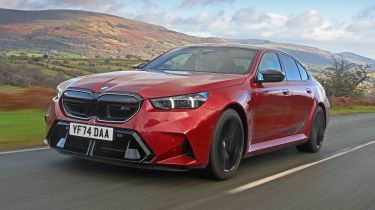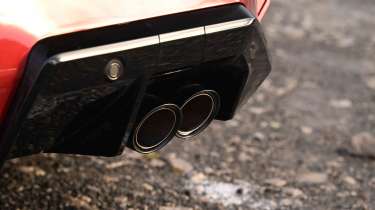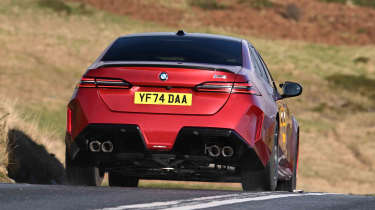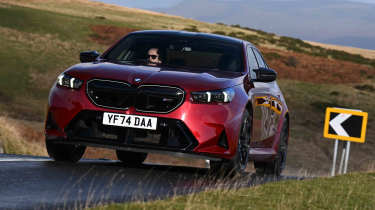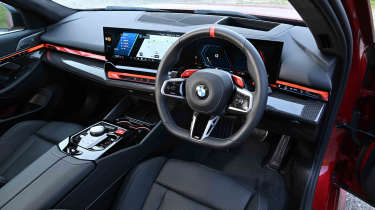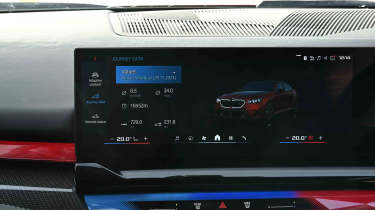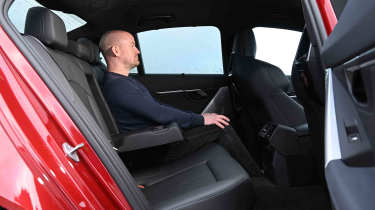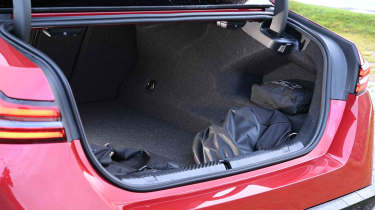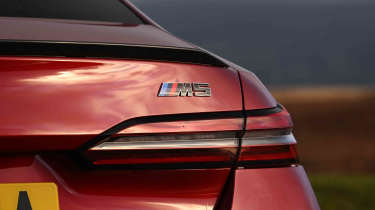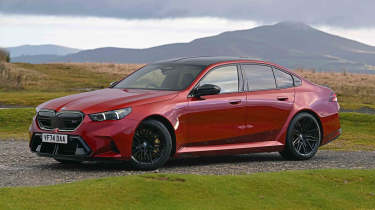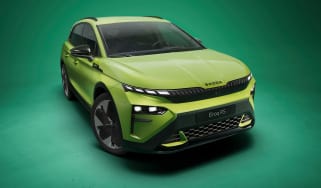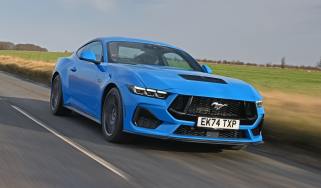BMW M5 review – the most capable M5 ever is now a PHEV
“The BMW M5 isn’t just more powerful than before, it’s more economical and comfortable, but it lacks some of its trademark driving flair”
Pros
- Extremely quick
- Economical if you’re careful
- Practical
Cons
- Lacks some driving feel
- Engine sounds flat
- Expensive
Verdict – is the BMW M5 a good car?
The BMW M5 is an impressive super saloon or estate for the times we live in. It’s incredibly fast, surprisingly economical if you’re careful, able to run on electricity, and very comfortable. The problem is, it’s lacking some soul because of a slightly numbed driving experience and its heavy weight, but it serves as a remarkable basis on which to base more focused future iterations.
BMW M5 models, specs and alternatives
BMW’s M cars are the legendary hotted-up versions of the brand’s regular lineup of cars. The first saloon car to get the treatment was the 5 Series-based BMW M5 (the first M car ever was the standalone BMW M1 supercar) and it’s become an iconic model since then. That means this latest version has not only big boots to fill, but also bigger obstacles to overcome, such as more stringent emissions regulations and taxation.
For that reason, the biggest thing that separates the new M5 from the car it replaces is that it’s now a plug-in hybrid, using a combination of petrol and electric power to deliver the type of performance people will expect, while keeping emissions down and fuel economy frugal. As a result, the latest BMW M5 may even prove controversial amongst loyal fans, because it’s not solely petrol-powered as it has been in the past, and it’s also quite a bit heavier too.
 Top 10 fastest saloon cars 2025
Top 10 fastest saloon cars 2025
The latest BMW M5 is eye-wateringly expensive, starting from over £110,000 in saloon form, while the Touring estate costs £2,000 more, but it’s still on par with the Audi RS7 and significantly less expensive than the Porsche Panamera that’s got similar on-paper performance. It’s very well equipped, at least, and there aren’t any trim levels as such, but buyers can specify lots of optional extras such as an M Driver’s Package which bumps the top speed up from 155mph to 189mph.
There’s no hardcore Competition Pack like the one offered on the M3, but it’s still early days and no doubt more performance-focused versions of the M5 will arrive later down the line.
Our UK drive of the BMW M5 confirms our initial thoughts from driving the left-hand drive model in Europe. While it’s an undoubtedly impressive machine and blisteringly quick, there’s a notable lack of feel through the steering wheel and there’s something clinical and cold about it. That could be intentional, though, leaving space for special, even more visceral versions later on.
| Trim levels | Power options |
|
|
There are currently discounts on the recommended retail price of BMW M5 models via our sister site Auto Express' marketplace
MPG, running costs & CO2 emissions
This time around, the BMW M5 is no longer a petrol-only model but instead powered by a combination of petrol and electric power by way of a plug-in hybrid system. That means it’s got the lowest on-paper CO2 emissions and best fuel economy of any BMW M5 that’s come before it, plus the ability to drive for up to 42 miles on electricity alone.
It should make the latest M5 the most affordable generation ever to live with, as you can manage short trips to the shops or around town without using a drop of fuel. It gives it a unique selling point versus petrol rivals like the Audi RS6, and means anyone looking to run an M5 as a company car will face significantly reduced bills.
Of course, this all depends on your driving and lifestyle, because you’ll need to keep the battery constantly topped up if you’re to come anywhere near BMW’s quoted economy figures. Charging up via a home wallbox charger at speeds of 7.4kW will take you around three hours and 15 minutes, while BMW says this will soon be upgraded to 11kW which will bring that time down to just two hours, so long as you have a compatible charger.
| Model | Fuel economy | CO2 emissions |
| BMW M5 | 176.6mpg | 37g/km |
| BMW M5 Touring | 166.6mpg | 39g/km |
How efficient is the BMW M5 in the real world?
While the BMW M5’s lofty fuel-economy figures are impressive, bear in mind that these are only attainable by keeping it charged and by driving in a less spirited manner. During testing we achieved average fuel consumption of between 33 and 35mpg over two days – that’s still impressive for a car with this much power on offer, and from such a large engine. Later, on our UK drive, we achieved 34mpg, so it seems like this is a realistic average figure to expect in the M5 long-term.
However, drive the M5 with reckless abandon and expect fuel efficiency to plummet. In Dynamic and Dynamic Plus drive modes, fuel economy went right down to as little as 18mpg.
How much will the BMW M5 cost in tax?
Because of its status as a low-emissions vehicle thanks to that plug-in hybrid powertrain, the BMW M5 should be less expensive than ever to run as a company car because BiK (Benefit-in-Kind) tax rates should be low. Bear in mind, however, that the regime by which plug-in hybrids are tested for fuel efficiency is set to get more stringent in 2025 to make it a better reflection of real-world driving conditions, and that means the low on-paper CO2 emissions figures could climb significantly, and thus will BiK rates.
What will the BMW M5 cost to insure?
Official insurance group ratings for the latest M5 are yet to be confirmed, but we’d expect it to sit in the highest group 50 out of 50, making it expensive to insure.
Engines, drive & performance
This generation of BMW M5 is the most complex there’s ever been. It swaps pure petrol power for a plug-in hybrid setup, which could irk some purists, but it does mean it’s the most powerful BMW M5 ever with 717bhp.
In many ways you could argue that the latest M5 doesn’t really go against the original recipe – it’s a car that’s designed to be easy to live with and as practical and classy as you can expect a saloon to be, but with all the performance and driver focus sitting dormant, ready to transform into something that would give a supercar a run for its money. The criteria for what makes a super saloon usable day to day has changed over time, so the fact you can glide along sedately in Electric mode at speeds of up to 87mph is very in-keeping with what modern car buyers are looking for.
It does make the M5 a very complicated piece of kit, though, so it took us time to come to our decision on whether it was good to drive or not. If you were worried that the M5’s engine would be toned down as part of the plug-in hybrid setup, then you’d be wrong, because there’s still a monstrous twin-turbocharged V8 engine under the bonnet, which gets its power bolstered further thanks to that electric motor.
There are five drive modes: Hybrid, Electric, eControl, Dynamic and Dynamic Plus. When you start the M5 it’s four-wheel drive by default, but you can switch it to two-wheel drive via the M Driver menu. The breadth of customisation is truly endless, and you’re able to fine-tune the settings for the engine, gearbox, chassis, steering and brakes via the M driver menu.
Dynamic and Dynamic Plus are the sportiest driving modes, and the only two in which the M5’s full 717bhp potential is available. Here, the sense of speed is very apparent from behind the wheel when you put your foot down – that’s quite impressive, especially because the BMW M5 is also very heavy given all the PHEV gubbins it has to haul around. Despite this, it feels even quicker than rivals like the 300kg lighter Audi RS6.
However, while it’s certainly fast, we’re not the biggest fans of how it sounds getting up to full pelt. The V8 engine note can be enhanced via system settings, but no amount of tweaks make it as sonorous as its rawer forebears. There’s a lack of depth to the engine which makes it feel a little artificial and flat, which is a little disappointing.
At the other end of the spectrum you’ve got the electric motor to keep things calm and serene. It’s incredibly smooth in Electric mode and means the M5 car glides along silently without fanfare when you need it to. You can do so up to 87mph before the combustion engine takes over.
As we’ve already established, the BMW M5 is well capable of delivering its performance, despite its weight, and its brakes are immensely powerful too. We were impressed with how well the M5 rides as well, even when it’s put into Dynamic mode. Grip is fantastic thanks to the huge 20 and 21-inch Michelin Plot Sport 5S tyres. Four-wheel steering, four-wheel drive and a well-judged suspension setup mean it’s well planted no matter what you throw at it.
We’ve now tried the M5 Touring – which is offered for just the third time out of seven generations – and the main difference is slightly softer rear suspension, for a more cosetting ride. It’s easy to spot the change, and we actually think it suits the M5’s character better. Far from being a B-road missile – the M5 is too big nowadays – the Touring is better suited to high-speed cruising on sweeping main roads and motorways.
However, despite all these undeniably impressive qualities, the BMW M5 offers very little in the way of feedback through the steering or from the driver’s seat. While the steering response is excellent and grip is infallible, it just feels rather numb. It’s possible that’s been done on purpose, though, with more engaging versions of the model set to arrive in future to cater for more hardcore buyers. The hefty kerbweight is another issue – while it’s amazing what BMW’s engineers have achieved with the latest M5, we can’t shake the feeling that it could have been even more impressive if it was 500kg lighter.
Plug-in hybrid models
The BMW M5’s plug-in hybrid setup boasts an eye-watering 717bhp and comprises a 4.4-litre twin-turbocharged V8 engine paired with an electric motor. That means it does the 0-62mph sprint in just 3.5 seconds, when fitted with launch control. Specify the M Driver’s Pack and the 155mph top speed is increased to 189mph.
| Model | Power | 0-62mph | Top speed |
| BMW M5 | 717bhp | 3.5 seconds (with launch control) | 155mph (189mph with M Driver’s Pack) |
Electric models
While it’s not a full-blown M car, the most hardcore version of the all-electric BMW i5 gets some of the M treatment in M60 xDrive form, which boasts two electric motors supplying it with 593bhp.
Interior & comfort
BMW has been on a roll with its interior designs for years now, and the BMW M5 is no different. The M5’s cabin feels well built and beautifully finished just like that of the standard 5 Series, and it’s incredibly hi-tech, with its curved single panel housing the driver’s display and infotainment.
We like how easy all of the car’s instruments are to read, and the steering wheel gets two M buttons that can be configured to your preferred Dynamic drive settings. Changing between drive modes also changes the feel of the cabin, with the ambient lighting defaulting to more calming colours in Comfort, and aggressive red tones when in Dynamic. Track mode tones every visual distraction down and the instrument display gets more focused, with just revs, tyre temperature, fluid temperature and other vital info shown.
Is the BMW M5 infotainment and sat-nav system easy to use?
The M5’s 14.9-inch infotainment screen looks incredibly crisp and slick and it’s easy to use for the most part. Just like in the standard 5 Series, it’s pretty easy to navigate the menus and there’s a Quick Select function that makes it even easier to jump to your favourite features without having to wade through too many submenus. We do wish there was quicker access to the ‘M-specific control panel’ where you can choose between the Normal, Dynamic and Track display settings, as well as yet more menus. It can be distracting to access these on the move as a result.
We like the 12.3-inch display that sits ahead of the driver – this shows all the main vehicle information concisely and vibrantly, and there’s a head-up display as standard, so you can keep your eyes on the road.
The Bowers & Wilkins sound system is made up of 18 speakers and a 655-watt amplifier with surround sound. It’s one of the best sound systems of any car we’ve driven and you can even swap the sound of music for the enhanced sound of the twin-turbo V8, should you wish to.
Key features |
|
M5
|
Boot space, practicality & dimensions
Plug-in hybrid systems often rob space from the interior and boot, but the M5 offers lots of space inside. This current generation of M5 has very large dimensions, which means it’s got plenty of road presence, which is helped by its sportier styling and bodykit.
There’s abundant space for occupants, so as a result it’s just as comfortable to ride in for long journeys as any other BMW. It may just be the most practical and comfortable M car there’s ever been, with lots of legroom and five sets of seatbelts.
| Size comparison | |||
| Model | Length | Width | Height |
| BMW M5 | 5,096mm | 1,970mm | 1,510mm |
| Mercedes-AMG E 53 | 4,955mm | 1,860mm | 1,450mm |
| Audi RS6 | 4,995mm | 1,951mm | 1,460mm |
| Lotus Emeya | 5,139mm | 2,005mm | 1,464mm |
Does the BMW M5 have a big boot?
The BMW M5 boasts a surprisingly sizable 466-litre boot. It’s a good shape, too, so you should be able to get four good-sized suitcases in there with no problem. Every M5 gets a powered tailgate, which makes getting items in and out much easier if you’ve got your hands full.
The BMW M5 also comes as an estate Touring version, should you want even more boot space. There’s a wider opening to the hatchback tailgate, while the boot capacity is 500 litres, increasing to 1,630 litres with the rear seats down – placing it just behind the Audi RS6 with 565 and 1,680 litres respectively.
| Boot space comparison | |
| Model | Boot space |
| BMW M5/ M5 Touring | 466 litres/ 500 litres |
| Mercedes-AMG E 53/ Estate | 370 litres/460 litres |
| Audi RS6 Avant | 565 litres |
| Lotus Emeya | 509 litres |
Reliability & safety
While the BMW M5 is a niche performance-focused model that won’t sell in high enough numbers to feature on our Driver Power customer satisfaction survey, BMW as a brand has been on the up in recent years, with the company placing in 14th position in the most recent 2024 brand survey. Customers love their cars’ engines, ride and handling, and infotainment tech, but value for money and running costs are ranked poorly. With the M5’s plug-in hybrid system keeping running costs down that shouldn’t be so much of an issue, but with it costing so much to buy in the first place, we doubt running costs will be high on buyers’ priority lists.
How safe is the BMW M5?
The BMW 5 Series was tested by Euro NCAP in 2023, and its five-star rating will also be applicable to the M5. Adult occupant protection was rated at 89%, child occupant protection at 85% and vulnerable road user protection at 86%. For its comprehensive suite of safety assistance features, the 5 Series achieved 78%.
Should you buy a BMW M5?
We think the BMW M5 is a fantastic option for those after a staggeringly-fast super saloon or estate that also doubles as an economical everyday car, that can even run on electricity for some of the time thanks to its plug-in hybrid system. What’s even more impressive is how comfortable it is, too, despite the potential that lays dormant in the background.
The thing is, while the M5 is undoubtedly quick, it doesn’t offer the most visceral experience, and there’s very little driving feel from behind the wheel. The V8 engine isn’t quite as sonorous as we’d like, and it’s a heavy car that – as impressively capable as it is – isn’t able to fully disguise its weight on the move. The M5 is brilliant and technically impressive in its own right, but perhaps it’s better to view it as a competent platform to build on for more focused versions on the horizon, that could appeal more to driving enthusiasts.
What is the Carbuyer pick of the BMW M5 range?
We think it’s worth going for the M5 Touring for the minimal £2,000 premium over the saloon because it adds that extra dose of practicality, while still boasting those impressive on-paper performance figures.
BMW M5 alternatives
Alternatives to the M5 include the Mercedes-AMG E 53, Porsche Panamera GTS and Audi RS6, though the latter is soon set to be replaced with a model of a different name following Audi’s revised naming structure. There are also electric rivals to consider, too, though the driving experience is less comparable.
How we tested the BMW M5
We tested a left-hand drive version of the BMW M5 in October 2024 in Munich, Germany, along with the Touring estate version.
Which Is Best?
Cheapest
- NameM5 4dr DCT
- Gearbox typeSemi-auto
- RRP£111,995
Most Economical
- NameM5 4dr DCT
- Gearbox typeSemi-auto
- RRP£111,995
Fastest
- NameM5 4dr DCT
- Gearbox typeSemi-auto
- RRP£111,995
